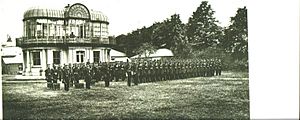Henry James (British Army officer) facts for kids
Sir Henry James (1803–1877) was a very important officer in the Royal Engineers, a special part of the British Army that deals with engineering and mapping. He was the boss of the Ordnance Survey, which is the official mapping agency for the British Government, from 1854 to 1875. The Ordnance Survey itself once called him "perhaps Ordnance Survey's most eccentric and egotistical Director General." Sir Henry spent most of his life working for this mapping agency. When he became its head, he brought in the new science of photography. He also later said he invented a special printing method called Photozincography. Sir Henry also helped solve a big debate about map scales.
Contents
Early Life and His Start in Mapping
Sir Henry James was born in 1803 in a place called Rose Vale in St Agnes, Cornwall. He was the fifth son of John James and Jane Hoskers. He went to a grammar school in Exeter and then studied at the Royal Military Academy, Woolwich. After finishing his studies, he joined the Royal Engineers as a second lieutenant on September 22, 1826. He was promoted to captain in 1846 and then to Colonel in 1857.
In 1827, he joined the Ordnance Survey. He spent most of his career working there, mainly in Ireland. After a short time working for the Admiralty (the British Navy's department), he eventually became the head of the Ordnance Survey office in Edinburgh in 1850. His appointment to lead the entire Ordnance Survey was a bit controversial. This was because his father-in-law, Major-General Edward Watson, helped him get the job over two other people who seemed more likely candidates.
Sir Henry married Anne, who was the daughter of Major General Watson.
Leading the Ordnance Survey
In 1854, when he was 51 years old, Sir Henry became the Superintendent of the Ordnance Survey. He took over from Lieutenant Colonel Lewis Hall. Sir Henry had much more experience than his predecessor, having worked for the Survey for most of his life.
When he became the director, Sir Henry got involved in a big debate called the "battle of the scales." The Ordnance Survey had mapped a large part of the country, but they still hadn't decided what map scale was the most useful. Sir Henry strongly believed in the 1:2500 scale. He used his position to make this change happen, even though his bosses weren't fully on board with it.
New Ways to Make Maps
In 1855, James created a photography department for the Ordnance Survey. He did this to find new ways to make maps smaller and easier to print. He claimed he invented photozincography, which was a photographic way to make printing plates. Actually, two of his staff members had developed this process. However, James was the main person who pushed for using this process to create and publish a copy of the Domesday Book in the 1860s. The Domesday Book is a very old and important record from England.
Sir Henry has been called one of the best "image builders" the Ordnance Survey ever had. This is because he made all the new discoveries and methods from his department freely available to others. Many foreign governments were very impressed by this. The Queen of Spain even made him a member of the Order of Isabella the Catholic in 1863. He had already received a knighthood in 1860 for his contributions to science.
Sir Henry James kept using his photozincographic process to save old historical papers. He published a whole series of English historical documents. This work continued even after he passed away. He also ordered the Ordnance Survey of Jerusalem, which was done to help improve the water supply for that city. A copy of this map is still kept at the National Archives today.
Retirement and Legacy
Because his health was failing, Sir Henry retired in 1875 at the age of 72. He had been the Director General of the Ordnance Survey for 21 years. His colleagues were happy about his retirement. Soon after he left, an article was published in the Hampshire Independent in 1875 that criticized how he had run the Survey.
Sir Henry James passed away on June 14, 1877, at the age of 75, at his home in Southampton. Even after his death, his impact on the Ordnance Survey remained. A plaque with his name and the date was put on every building at the Ordnance Survey offices that was built while he was in charge.


